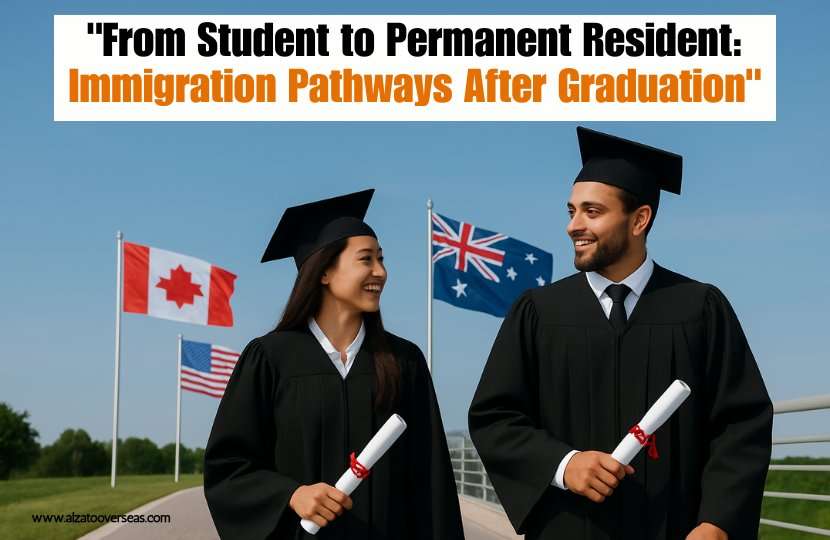Completing your university or college education is an exciting time; however, for many international students, it is also a time of uncertainty about staying in the country legally and eventually transitioning to permanent residency. The immigration pathways for graduating students can seem overwhelming, but understanding your pathways, the criteria for eligibility, and planning strategically can help put you on a path to your goals.
International education leads to pathways after graduation
The first thing to remember is that graduating from an international university can provide more potential than just a career. Many countries want to develop the international talent pool, and field competent graduates who develop and stay local is to everyone’s benefit. Many countries and universities have given options and pathways to students to stay and be productive members of society after their studies. This could include a work permit, a temporary residency program, and possible pathways to permanent residency, and much more. Understanding all of the rules, timelines, eligibility, and government-identification numbers to be able to begin planning for a future career and transition away from student to worker face is invaluable!
Post-Graduation Work Permits (PGWPs)
The Post-Graduation Work Permit (PGWP) allows international students to work in the country where they studied for a period after they have graduated, and it allows them to get valuable local work experience. The duration of the work permit is generally related to the duration of their study; typically, the longer the program, the longer the work permit will be. For example, in Canada, if students complete a two-year degree, they may receive a work permit that is valid for three years. Likewise, Australia wants students to work after they graduate and offers Temporary Graduate visas, while the US offers Optional Practical Training (OPT) work permits. A PGWP can also be the first step towards permanent residency for international students, as part of the experience needed to apply under many immigration programs includes actual work experience.
Regional or Provincial Nominee Programs
Some countries have established region-specific immigration pathways to attract talent to less-populated or strategically significant areas. For example, Canada’s Provincial Nominee Programs (PNPs) allow individual provinces to nominate graduates who meet local demand in their labor market. As a pathway to permanent residency, this can be a much quicker and easier option than working through the federal immigration programs. Australia also has state-nominated visas that create another path for international graduates to obtain permanent residency, especially in regions that have skill shortages. The choice of region can be a matter of strategic thinking with an approach to career development and immigration.
Family and Dependent Factors
Often, after graduation, the immigration pathways can extend to family members. For example, many nations provide international graduates with the opportunity to sponsor a spouse and dependent children as part of their immigration under a specific immigration pathway. This factor is important for students who are looking to reside abroad on a long-term basis for various reasons, as it will serve as a primary influence on overall well-being and work-life harmony. In addition, understanding how family circumstances would influence eligibility, required documents, and timelines for processing allows families to take a joint approach to settling in their new home as seamlessly as possible.
Legal and Documentation Requirements
The process of switching from a student visa to permanent residency has some legal obligations and documentation requirements. It is necessary to adhere to the legal requirements and requirements in the migration system correctly while completing the application. Generally, graduates are expected to maintain their legal status while applying for work permits or solving immigration issues, submit the right application at the right time, and primarily comply with deadlines. Important documents to consider when planning the application may include education credentials, letters of employment, language testing results, and proof of funds. Seeking advice or information from immigration advisers or university international offices may prevent the applicant from considerable stress and inconvenience due to an error that may hinder or halt the immigration process.
Strategic Planning in Support of Career and Immigration Goals
Obtaining permanent residency once you have graduated is a strategic plan. You will want to consider what you are studying, where you work, and how your experience aligns with immigration requirements. Demand is greatest in particular fields, actively seeking out internships, co-op placements, and building relationships with potential employers can be beneficial in increasing your chances of obtaining the work experience you need for permanent residency. Having a plan for your future will help once you graduate to consider timelines, eligibility, and options should your first application(s) not be successful.
Conclusion
Transitioning from a student to a permanent resident can be a challenging journey, however, with appropriate support, the journey will become manageable and beneficial. It is very important to with the different immigration options available to you after graduation, such as work permits, employer sponsorship or skilled migration programs. Alzato Overseas Education Consultant is passionate about the success of international students. And support student in their transition from study to the start of your permanent life overseas. With appropriate planning and advice from study abroad consultant this process can enable your dream of a new life abroad to become reality.
For more information related to overseas education visit https://alzatooverseas.com/blog/ or book a free foreign education counselling at https://apply.alzatooverseas.com/

